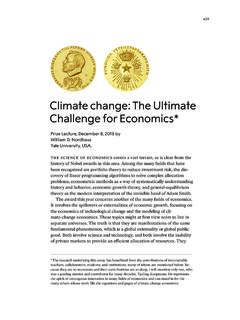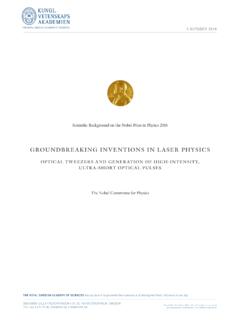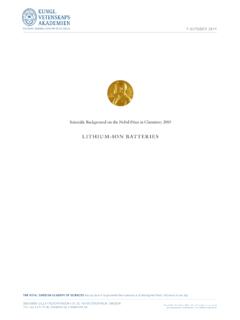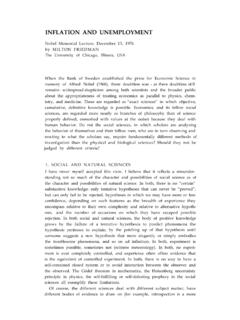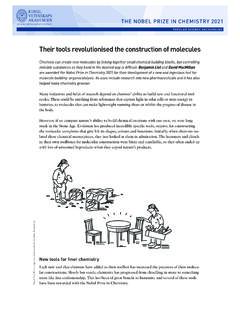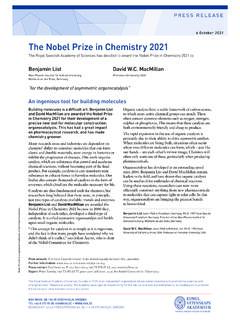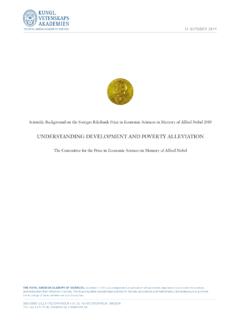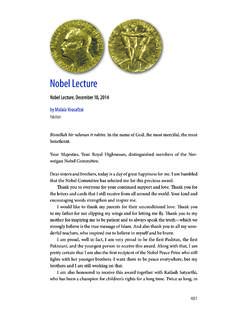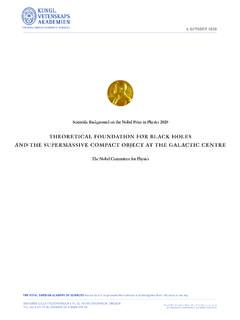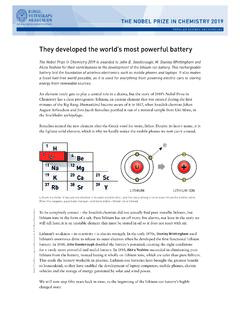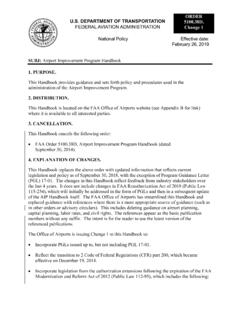Transcription of ANSWERING CAUSAL QUESTIONS USING OBSERVATIONAL …
1 1 1 OCTOBE R 2021. Scientific Background on the Sveriges Riksbank Prize in Economic Sciences in Memory of Alfred Nobel 2021. ANSWERING CAUSAL QUESTIONS USING OBSERVATIONAL DATA. The Committee for the Prize in Economic Sciences in Memory of Alfred Nobel THE ROYAL SWEDISH ACADEMY OF SCIENCES, founded in 1739, is an independent organisation whose overall objective is to promote the sciences and strengthen their influence in society. The Academy takes special responsibility for the natural sciences and mathematics, but endeavours to promote the exchange of ideas between various disciplines. BOX 50005 (LILLA FRESCATIV GEN 4 A), SE-104 05 STOCKHOLM, SWEDEN. TEL +46 8 673 95 00, ANSWERING CAUSAL QUESTIONS USING OBSERVATIONAL DATA. Most applied science is concerned with uncovering CAUSAL relationships. In many fields, randomized controlled trials (RCTs) are considered the gold standard for achieving this. The systematic use of RCTs to study CAUSAL relationships assessing the efficacy of a medical treatment for example has resulted in tremendous welfare gains in society.
2 However, due to financial, ethical, or practical constraints, many important QUESTIONS particularly in the social sciences cannot be studied USING a controlled randomized experiment. For example, what is the impact of school closures on student learning and the spread of the COVID-19 virus? What is the impact of low-skilled immigration on employment and wages? How do institutions affect economic development? How does the imposition of a minimum wage affect employment? In ANSWERING these types of QUESTIONS , researchers must rely on OBSERVATIONAL data, , data generated without controlled experimental variation. But with OBSERVATIONAL data, a fundamental identification problem arises: the underlying cause of any correlation remains unclear. If we observe that minimum wages and unemployment correlate, is this because a minimum wage causes unemployment? Or because unemployment and lower wage growth at the bottom of the wage distribution leads to the introduction of a minimum wage?
3 Or because of a myriad of other factors that affect both unemployment and the decision to introduce a minimum wage? Moreover, in many settings, randomized variation by itself is not sufficient for identification of an average treatment effect. This year's Prize in Economic Sciences rewards three scholars: David Card of the University of California, Berkeley, Joshua Angrist of Massachusetts Institute of Technology, and Guido Imbens of Stanford University. The Laureates' contributions are separate but complementary. Starting with a series of paper from the early 1990s, David Card began to analyze a number of core QUESTIONS in labor economics USING natural experiments , , a study design in which the units of analysis are exposed to as good as random variation caused by nature, institutions, or policy changes. These initial studies on the minimum wage, on the impact of immigration, and on education policy challenged conventional wisdom, and were also the starting point of an iterative process of replications, new empirical studies, and theoretical work, with Card remaining a core contributor.
4 Thanks to this work, we have gained a much deeper understanding of how labor markets operate. In the mid-1990s, Joshua Angrist and Guido Imbens made fundamental contributions to the challenge of estimating an average treatment effect. In particular, they analyzed the realistic scenario when individuals are affected differently by the treatment and choose whether to comply with the assignment generated by the natural experiment. Angrist and Imbens showed that even in this general setting it is possible to estimate a well-defined treatment effect the local average treatment effect (LATE) under a set of minimal (and in many cases empirically plausible). conditions. In deriving their key results, they merged the instrumental variables (IV) framework, common in economics, with the potential-outcomes framework for CAUSAL inference, common in statistics. Within this framework, they clarified the core identifying assumptions in a CAUSAL design and provided a transparent way of investigating the sensitivity to violations of these assumptions.
5 The combined contribution of the Laureates, however, is larger than the sum of the individual parts. Card's studies from the early 1990s showcased the power of exploiting natural experiments to uncover CAUSAL effects in important domains. This early work thus played a crucial role in shifting the focus in empirical research USING OBSERVATIONAL data towards relying on quasi- experimental variation to establish CAUSAL effects. The framework developed by Angrist and Imbens, in turn, significantly altered how researchers approach empirical QUESTIONS USING data generated from either natural experiments or randomized experiments with incomplete compliance to the assigned treatment. At the core, the LATE interpretation clarifies what can and 1. cannot be learned from such experiments. Taken together, therefore, the Laureates' contributions have played a central role in establishing the so-called design-based approach in economics.
6 This approach aimed at emulating a randomized experiment to answer a CAUSAL question USING OBSERVATIONAL data has transformed applied work and improved researchers' ability to answer CAUSAL QUESTIONS of great importance for economic and social policy USING OBSERVATIONAL data. The design-based approach: background At least until the 1980s, the traditional approach to CAUSAL inference in economics relied on structural equation models that is, on the specification of systems of equations capturing behavioral relationships; see Wright (1928) and 1989 Laureate Trygve Haavelmo (1943, 1944). A. key concern with the structural equation approach, however, is that in order to establish a CAUSAL relationship, the proposed structure has to be correctly specified. By the early 1980s, the difficulties associated with correctly specifying a structural model for CAUSAL inference became Ashenfelter (1978) pointed to the difficulties of evaluating job training programs and Lalonde (1986) showed that experimental estimates, obtained from a randomized evaluation of a job-training program, were systematically different from the estimates obtained by applying standard econometric methods to OBSERVATIONAL data from the same program.
7 These results provided an important impetus to the Laureates' innovations that were to come. The design-based approach: new credible evidence based on natural experiments In response to the findings in, , Lalonde (1986), labor economists in the late 1980s turned to exploiting data generated by natural experiments. Under certain circumstances, the variation induced by (changes in) nature, policy , or institutions, implies that we can separate those affected by the treatment from those that were not, as if assignment to treatment was random. Examples of early, and highly influential contributions include Angrist (1990), Card (1990), Angrist and Krueger (1991), Card and Krueger (1992a, 1994). While economists were not the rst to advocate a quasi-experimental approach for CAUSAL inference, the systematic use of quasi-experimental variation to address QUESTIONS of great significance to economic and social policy quickly changed the practice in applied microeconomic research and This change was not primarily about USING new empirical methods, but rather about how to approach a CAUSAL question.
8 The natural experiment agenda required researchers to understand the process determining which units receive which treatments. The new approach thus required an understanding of the source of identifying information, , it required institutional knowledge about the natural experiment. The use of arguably exogenous variation to estimate CAUSAL effects provided new, credible, and highly policy -relevant evidence. These initial findings stimulated new research, and research results are thus cumulating. Card's work on minimum wages provides a good example of this iterative process. According to the textbook competitive model of the labor market, an increase in the minimum wage yields a substantial reduction in employment a result that was broadly supported by the available evidence in the late 1980s. Card and Krueger (1994) challenged this conclusion. USING a natural experiment, with data from two neighboring states in the US one in which the minimum wage was increased they showed that the increased minimum wage did not have a negative employment impact.
9 This finding stimulated reanalysis USING data for the US as well as other countries; the overall conclusion from this extensive literature is that the negative employment impact is limited. Card and Krueger's results also generated empirical and theoretical 1 At the time there was a general concern with the inability to credibly establish CAUSAL claims. See, for example, Hendry (1980), Sims (1980), and Leamer (1983). 2 Already in the 1960s, Donald Campbell discussed USING institutional reforms and institutional rules in education to estimate CAUSAL effects (see Section 1). 2. work trying to explain the lack of negative employment effects. Several empirically supported explanations have been offered. One explanation is that the cost per efficiency unit of labor does not rise one for one with minimum wages; for instance, evidence shows that worker productivity improves following the introduction of a higher minimum wage.
10 Another explanation is that local service providers, which are most affected by the minimum wage, are able to shift the cost increase onto consumers in the form of higher prices without much loss in product demand. A third explanation is that firms have monopsony power in the labor market; with monopsony power, the effect of the minimum wage is ambiguous because of countervailing effects on labor demand and labor The minimum wage literature thus prompted a revival of research on the consequences of monopsony in the labor market and the contribution of firm wage setting to (changes in) wage inequality. While it would be inappropriate to conclude that increases in the minimum wage never have negative employment effects, we have a much deeper understanding of why this may or may not be the case than we did 30 years ago. The design-based approach: the LATE framework The findings from the initial wave of studies exploiting natural experiments raised conceptually important issues.
